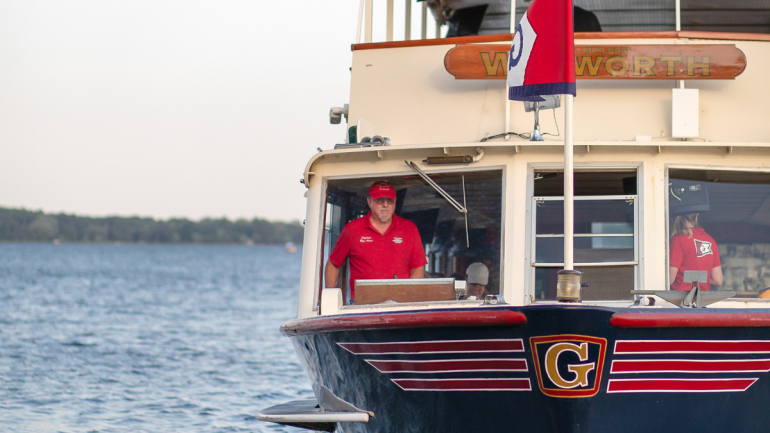By Amanda N. Wegner | Photos by Shanna Wolf
Ray Ames’ path to becoming captain of Geneva Lake’s most famous boat has been anything but conventional. “It’s hard to explain the course from dairy farm, to band room, to Mailboat, but here I am,” says Ames. “It seems to have worked well, was a good fit, and I consider myself fortunate to do what I do. It’s a dream job, really.”
Ames is the captain of Lake Geneva Cruise Line’s Walworth II, more commonly known as the Mailboat, which serves as one of the last remaining marine mail delivery vessels in the country. Athletic young adults known as “mail jumpers” deliver mail to lake homes by leaping off and back onto the moving Mailboat, which passes just inches from homeowners’ piers, requiring expert skills on the part of the captain. Tryouts to land one of the coveted mail jumper positions take place every year in May, and frequently make the national media. This year, Ames and the Mailboat will also be a part of the 150th anniversary celebration of Lake Geneva Cruise Line’s parent company, Gage Marine, which started as the Wisconsin Transportation Company in 1873.
FROM MR. AMES TO CAPTAIN AMES
A landlubber at the start, Ames grew up on a Walworth County dairy farm, which, he says, “didn’t come with boat experience.” In fact, before he was Captain Ames, he was Mr. Ames, the band director at Lake Geneva’s middle school for 35 years. As a child, Ames was “very into music,” and after graduating high school, he headed to UW-Eau Claire and earned a degree in music education. Upon graduating from college, Ames cast a wide net looking for a job. “I looked at Illinois, Michigan, Iowa, Minnesota, Texas and Alaska,” he explains. “I was set to do one of those things [in Alaska] where they fly you out [to a remote location] and then they pick you up in June, but then I got a job in Lake Geneva and have been here ever since. I thought I’d have to work my way back here, but it was my first job, and I never left.”
Ames taught generations of local students to play everything from the flute to the timpani. Though he retired from full- time teaching in 2013, he continues to teach music part-time at Reek Elementary School in Linn Township, and also assists his daughter, who now serves as a middle school band director, once a week.
During all that time, Ames has never retired from the water. Like many other teachers seeking summer work, Ames gravitated to Lake Geneva Cruise Line, a company which operates a majority of its business during the summer months when school is out of session. “This is my 45th year of teaching, and I’m starting my 45th summer with the cruise line,” he says proudly.
TAKING THE HELM
In his first year at the cruise line, Ames served as a crewman, then worked his way up to an engineer on the cruise line’s steam-powered boat, the Louise. Eventually, he started picking the brain of longtime captain Neill Frame, who helmed the Mailboat for over three decades. “Neill, who I replaced, worked seven days a week for 30-some years, every single Mailboat trip,” Ames says. “Then, as [Neill] got later in his career, we decided I should get trained for the Mailboat.”
The Mailboat is a rare amenity for those who own lakefront homes. From mid-June through mid-September, residents who live on the lake can opt- in for marine mail delivery, a vestige of a period in the early 20th century when many lake homes were not easily accessible by road. Today, as it has from the Mailboat’s inception in 1916, Lake Geneva Cruise Line also uses the Mailboat tour to entertain passengers who want a closer view of the lake’s estates and points of interest, while also enjoying the spectacle of the mail jumpers.
About 20 years ago, Ames began his tenure as Mailboat captain by covering Sundays and holidays (even on those days when the United States Postal Service is closed, jumpers still deliver newspapers). This allowed him to learn the ropes while giving Frame some time off. Captaining the Mailboat requires complex boat handling skills in order to get close enough to the piers for the mail jumpers to safely leap to and from the boat. The Mailboat captain is also required to navigate other obstructions like buoys, boats and swimmers.
Ames says he relied on his upbringing on a dairy farm to guide him as he learned. “In hindsight, I was always attracted to water and fascinated with boats, but I didn’t know [boat handling] because I didn’t have the opportunity,” he explains. “It certainly wasn’t a slam dunk, but when you grow up with dairy and crops, you gotta figure out how to do stuff. They show you one time how to run equipment, and then you get a new piece, and you have to figure out how to use it, how not to break it and be safe with it. That naturally lent itself to figuring out how to control the boat in all conditions. It was something I picked up fairly quickly and intuitively. It’s not the same, but there are many similarities.”
When the time came for Ames to captain the Mailboat full-time, he says he was able to take it over “fairly seamlessly.” Ames works five days a week, and another captain, Jeff Clapp, works the other two days. Ames admits that neither of them are “all that young,” however. “We need to start looking at who will do this next.”
THE CHALLENGE AND THE PRESTIGE
When the Mailboat started delivery in 1916, there were only about 50 homes on the lake, and most of the piers were a quarter- to a half-mile apart, allowing the boat to easily navigate between them. Now, Ames says, there are around 1,300 piers on Geneva Lake — many not even one boat-length apart — and over 5,000 boats moored on the lake in the summers. “We have to work our way through all that stuff,” says Ames. “It’s a challenge. Some love us. Others, not so much.”
During peak season, Ames maneuvers the boat to nearly 60 piers for mail delivery, careful never to touch or bump the piers with the large boat. “With the Mailboat, you have to make the approach, pull out and drive on past, yet get close enough for the jumper to get on and off,” he explains. “If you do touch the pier, it is a brush, not a crunch. That’s a big adjustment from driving a regular boat. It has to be kind of an obsession to get it right, to know the lake, to be that precise. It’s inherently challenging.”
Deliveries are also inconsistent, as the demographics of the lakefront residents have changed. Ames notes that, of the homeowners who opt for marine mail delivery, there are only three or four year-round residents; everyone else is a seasonal resident, some of whom he describes as “amazingly seasonal.” In addition, as more people get their news digitally and enroll in automatic billing, mail volume has dropped. “Some people are only at these houses for a handful of days over the summer,” he explains. “And it’s a challenge to keep the homeowners signed up for the service and involved in their own mail collection. But, fortunately, it’s still a popular tradition.”
Increased traffic on the lake also makes the captain’s job more challenging, as well as one of the lake’s more contentious sports: wakesurfing. “[Wakesurfing boats] are designed to make big waves and have a tremendous wake,” says Ames. “Driving a boat like the Mailboat, if you hit one of those [waves] wrong, you’ll go crashing into a pier.”
And, of course, weather plays a role. “I think the hardest part is ensuring the boat is safe and enjoyable in any weather,” says Ames. “I don’t think we’ve ever canceled delivery, but some days we went late or got wet. But we always go out eventually.” The boat’s lower deck is enclosed. The upper deck has a canopy and vinyl curtains, but they can’t be closed during mail delivery — they need to remain open to allow the wind to blow through so the boat doesn’t crash into piers. And if the wind strength is more than three or four miles per hour, says Ames, it’s a fight to keep away from the piers.
“It’s an extremely challenging job, but there’s a certain amount of prestige,” says Ames. “I don’t want to blow my own horn, but I’m very proud of having worked my way up through every job at the company, to get to the point where I have the most visible job captaining the Mailboat. I tell people that, in a sense, it’s like being an offensive lineman in the NFL. You’re doing an extremely difficult job, but in most cases, it’s best when people don’t notice.”
EXPANDING A CAPTAIN’S SKILL SET
During the tour season, Ames does, in fact, blow his own horn. The former band director often plays songs on his trumpet to welcome passengers aboard. “It has evolved to the point that I have a spare trumpet I keep on the boat, and most mornings, if things are going right, I’ll grab the trumpet just before boarding,” he says. He likes that there’s a certain amount of shock value because passengers aren’t expecting it. “They don’t expect to have it as part of the captain’s skill set,” he says.
Ames has many fond memories from his years with the cruise line, but especially loves captaining a sold-out Mailboat on a beautiful day: “There is nothing better. A day with beautiful weather — that’s a bonus. That happens a few times a summer.” And he says he loved “getting to work alongside my three children, two of whom were mail jumpers.”
He is also fond of the many former students he’s worked with on the boat. In particular, he recalls a young, seventh-grade percussionist he met at Reek Elementary School who, after learning “Mr. Ames” was a boat captain, proclaimed she wanted to be a mail jumper someday. “She ended up being one of my best-ever mail jumpers and eventually became a boat captain — from seventh-grade band to Mailboat jumper to captain is quite a thing,” he says. “Her sister is a mail jumper now.”
But Ames says that one of the most rewarding aspects of the job is being a beloved part of the lake’s culture. “This is all about tradition,” he says. “The Mailboat signals summer and how much people love the lake,” says Ames. “To have people, especially kids, out on the piers every day to greet the Mailboat and make a handoff is something so special.”
Ames plans to keep at it as long as he can. “Most people are retired at my age,” he acknowledges. “I’ll do the Mailboat as long as they’ll have me, as long as I’m loving it and doing a good job. I hope I have a few more seasons in me. Same thing with teaching. It means a lot to me to bring that joy.”





